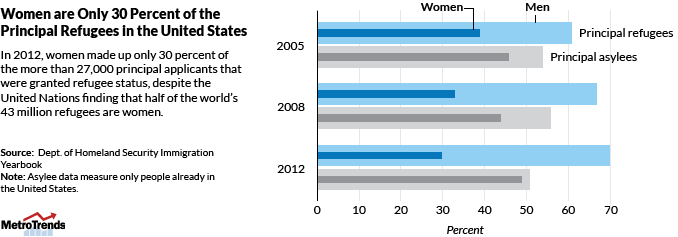
June 20th is World Refugee Day, a day established by the United Nations to honor the strength, courage, and determination of refugees. This prompted me to find out more about who US refugees are, besides the usual portrait of country of origin. In looking at refugee data published by the Department of Homeland Security (DHS), one fact caught my eye: the low representation of women among principal applicants (that is, the people directly petitioning for refugee status).
In 2012, women made up only 30 percent of the more than 27,000 principal applicants that were granted refugee status, even though half of the world’s 43 million refugees are women, according to the United Nations. Women refugees mainly enter the United States as a family member of a man who is a principal applicant for refugee status.
What is a refugee?
Refugees, as defined in section 101(a)42(A) of the Immigration and Nationality Act, are generally people outside their country of nationality who are “unable or unwilling to return to” their home country because of a “well-founded fear of persecution on account of race, religion, nationality, membership in a particular social group, or political opinion. Applicants must apply for refugee status before entering US territory. The preponderance of men in the principal applicant pool may be due to war and political persecution stemming from these wars, since most soldiers and people directly involved in wars are men. But if these men die or are imprisoned, they often leave behind widows, sisters, and mothers who are at risk of persecution and must apply for refugee status on their own. And women are also displaced from their homelands by conflict and persecuted for their ideas.
Asylum seekers are evenly split by gender
What got me thinking about why so few women are principal applicants for refugee status is that the gender distribution of asylum seekers is more equal. People seeking asylum must meet the definition of a refugee—meaning they have a well-founded fear of persecution—but asylees are either already in the United States (affirmative asylees) or are seeking admission at a US port of entry (defensive asylees). According to DHS, half of principal affirmative asylee applicants are women. Why is there such a big difference between women asylum seekers and women refugees?
The gender imbalance among principal refugees is troublesome and raises questions about whether women are getting a fair share of refugee admissions. The State Department, which is responsible for the Refugee Admissions Program, should look closely at the refugee application and determination processes to make sure women have as fair a chance of receiving safe haven as men do.
Tune in and subscribe today.
The Urban Institute podcast, Evidence in Action, inspires changemakers to lead with evidence and act with equity. Cohosted by Urban President Sarah Rosen Wartell and Executive Vice President Kimberlyn Leary, every episode features in-depth discussions with experts and leaders on topics ranging from how to advance equity, to designing innovative solutions that achieve community impact, to what it means to practice evidence-based leadership.
